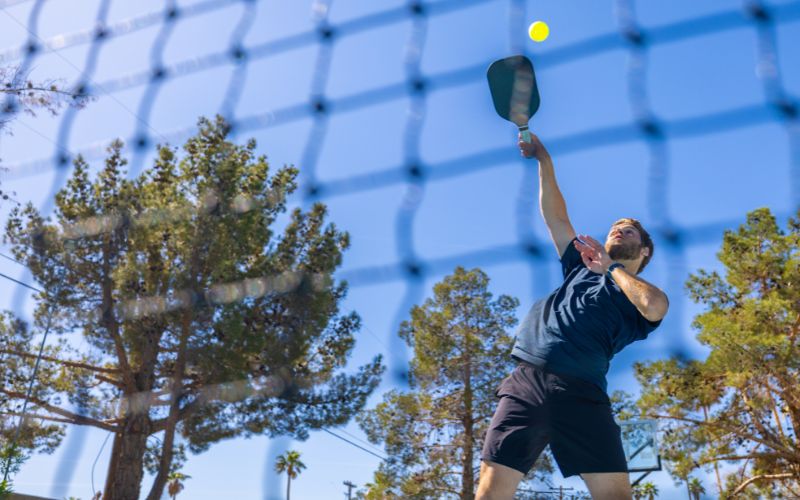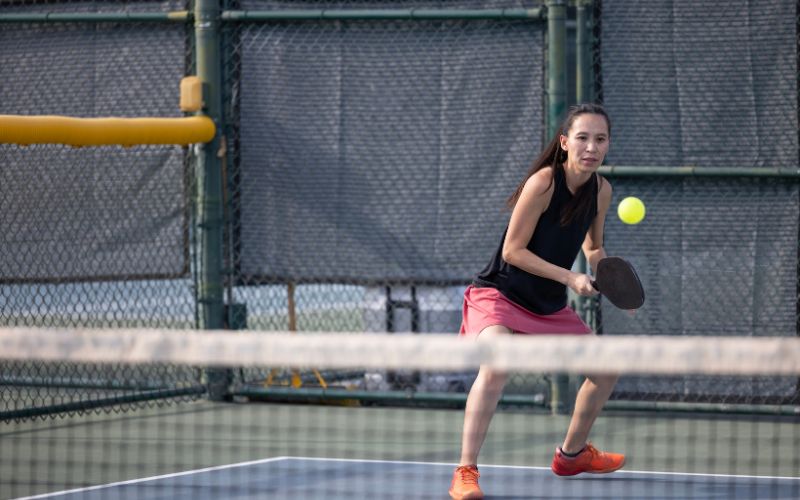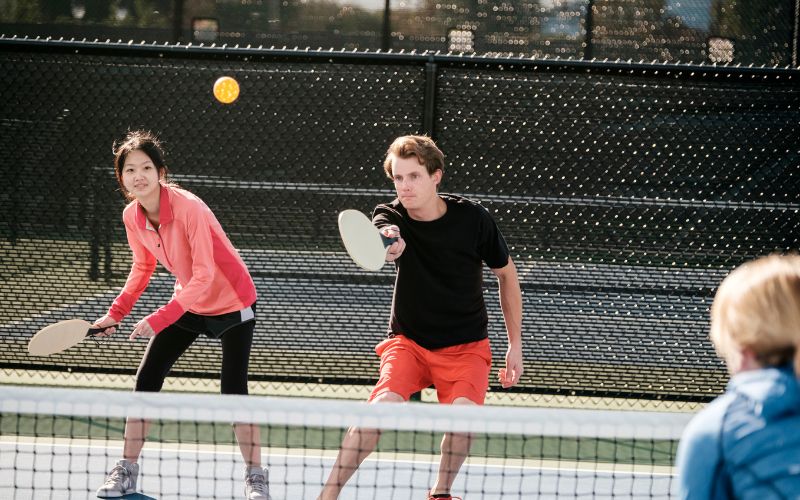Pickleball is more than just a sport; it’s a nuanced game of strategy and skill. To truly excel on the pickleball court, you need to master the art of strategy. In this comprehensive guide, we’ll delve deep into the world of pickleball strategy, exploring key tactics, mental aspects, offensive and defensive maneuvers, serving strategies, and much more. Whether you’re a beginner looking to up your game or an experienced player aiming to refine your skills, these insights will help you on your journey to pickleball strategy mastery.
The Fundamentals of Pickleball Strategy
Pickleball strategy is a combination of skill, decision-making, and anticipation. It’s about understanding the dynamics of the game and using that knowledge to your advantage. At the core of pickleball strategy are key tactics that players use to gain the upper hand.
What Is a Key Strategy in Pickleball?
A fundamental strategy in pickleball is the “Third Shot Drop.” This tactical move is employed during the early stages of a point, particularly after the serve and return. It involves gently dropping the ball into the opponent’s kitchen area, strategically positioning yourself for a stronger position at the net.
Here’s how the Third Shot Drop works and why it’s a fundamental strategy in pickleball:
Serve and Return: The point begins with the serving team serving the ball diagonally to the opposing team. The receiving team’s goal is to return the ball effectively while getting into a good position at the non-volley zone (also known as the “kitchen”).
Transition to the Kitchen: After serving and returning, both teams aim to transition to the kitchen, which is an area close to the net. Being in the kitchen allows you to control the game better, as it limits your opponents’ options.
The Third Shot: The Hit Drop Shots come into play when you’re in a position to hit the ball after the serve and return. Instead of hitting a powerful shot, which can be risky and result in the ball going out or into the net, the strategy is to softly drop the ball into the opponent’s feet. This gentle shot is designed to land just over the net and ideally in the first few feet of the opponent’s side of the court.
The key aspects of the Third Shot Drop are:
Soft Touch: It requires finesse and control. You want to gently tap the ball, ensuring it clears the net and lands softly.
Short Placement: The drop shot should ideally land in the opponent’s kitchen or close to it. Placing it short prevents your opponents from attacking with powerful volleys.
Angle Matters: Adjust the angle of your shot based on your position and your opponent’s positioning at the kitchen. The goal is to create an angle that makes it challenging for your opponents to return effectively.
The Role of Spin in Pickleball Strategy
Spin is a versatile and potent element in the world of pickleball strategy. It can be your secret weapon, enabling you to add finesse and control to your shots, while also confounding your opponents feet. In this section, we’ll explore the pivotal role of spin in pickleball strategy and how it can be harnessed to enhance your gameplay.
Types of Spin in Pickleball
Before delving into strategy, let’s briefly understand the different types of spin that players can employ:
Topspin: When the ball rotates forward in the direction it’s moving, it’s called topspin. Topspin shots tend to dive downward and accelerate, making them challenging to return. They are often used for aggressive offensive plays or when trying to keep the ball low over the net.
Backspin: Backspin is the opposite of topspin, where the ball rotates backward against its direction of motion. Backspin shots tend to float and bounce less upon landing, making them tricky for opponents to predict and control. They’re often used for soft drop shots and defensive play.
Sidespin: Sidespin occurs when the ball rotates sideways while moving forward. Sidespin shots can curve to the left or right, making them difficult to read. This can be especially effective in doubles play, where creating confusion between opponents is key.
Strategies for Using Spin
Deceptive Drop Shots
Adding backspin to a shot can create a slow, floating trajectory that can be challenging for your opponent to predict. Using this spin for drop shots can catch your opponents off guard and lead to points in your favor. By mastering the backspin, you can drop the ball right over the net, enticing your opponents into a challenging situation.
Control and Placement
Topspin can provide control and placement. It allows you to dictate the speed of the rally and maintain consistent ball placement. You can use topspin to keep the ball low, making it more challenging for opponents to attack. Utilize topspin when you need to maintain control of the point while waiting for an opportunity to strike.
Change of Direction
Sidespin can be an excellent tool for changing the direction of the ball after it crosses the net. Use it to send the ball curving away from your opponent’s paddle, making it difficult for them to predict where it will land. This can create confusion and potentially lead to mistakes on their part.
Attacking with Power
When you want to put the pressure on your opponents, incorporate topspin into your smashes and drives. The forward rotation can add speed and dip to the ball, making it challenging to defend against. Employ this strategy when you’re on the offensive and looking to take control of the point.
Defense with Backspin
In defensive situations, employ backspin to slow down the ball and reduce its bounce. This can make it harder for your opponents to attack and allow you to reset the rally. Utilize backspin when you find yourself in a defensive position, such as when returning a hard shot.
Mind Over Matter: Mental Aspects of Strategy
Pickleball is not just a physical game; it’s a mental one too. Developing a strong mental game is essential for maintaining focus, making split-second decisions, and staying resilient during intense rallies.
Offensive Strategies for Aggressive Play
Offense is a critical component of pickleball strategy. Knowing how to put pressure on your opponents and create opportunities for winners can be a game-changer. Learn about offensive tactics that can take your game to the next level.
What Is the Best Way to Improve in Pickleball?
Improving in pickleball involves honing your skills, developing your understanding of the game, hit shots and practicing consistently. We’ll provide you with tips to help you progress and become a better player.
There are several key ways to become a better pickleball player:
Consistent Practice: Regular practice is the backbone of improvement. Commit to playing pickleball as often as you can, whether it’s casual matches or more structured training sessions. The more you play, the better you’ll become.
Take Lessons: Consider taking lessons from experienced pickleball coaches or players. They can provide valuable insights, correct your technique, and offer personalized guidance to address your specific weaknesses.
Focus on Fundamentals: Ensure you have a strong foundation in the basics of pickleball. Work on your grip, footwork, and strokes. A solid understanding of the fundamentals will significantly impact your performance.
Learn from Others: Pay attention to players who are better than you. Watch games, both in person and online, to observe how advanced players approach the game. You can pick up valuable strategies, positioning, and shot selection by watching the pros.
Conditioning and Fitness: Pickleball can be physically demanding, especially in long, intense rallies. Improve your fitness level to endure longer matches and maintain peak performance. Regular cardio and strength training can help you build endurance and agility.
Mental Toughness: Don’t underestimate the importance of mental strength in pickleball. Stay focused, remain composed under pressure, and develop a resilient mindset. Visualization and relaxation techniques can help you stay mentally sharp during matches.
Review Your Matches: After each game, take some time to analyze your performance. Identify areas where you excelled and where you made mistakes. Self-assessment is a powerful tool for self-improvement.
Set Goals: Establish specific, achievable goals for your pickleball progress. Whether it’s mastering a particular shot, improving your serve, or winning a certain number of matches, having goals will keep you motivated and provide direction for your improvement.
Practice with Purpose: Rather than just playing recreational games, practice with a specific focus on your weaknesses. If your backhand needs work, for instance, spend extra time drilling and practicing it.
Play Against Varied Opponents: While practicing with consistent partners can help you develop teamwork and chemistry, also challenge yourself by playing against a variety of opponents. Different playing styles and strategies will help you adapt and improve your overall game.
Footwork and Positioning: Pay close attention to your footwork on the court. Proper positioning can make the difference between reaching a difficult shot or not. Improve your agility and court coverage through targeted drills.
Join a Club or League: Engage with the local pickleball community. Joining a club or league can provide a supportive environment for improving your skills, along with opportunities for regular play and competition.
Record Your Matches: Filming your games is a valuable way to gain insights into your playing style. Review the footage to see where you could have made different choices, taken better positions, or executed more effective shots.
Attend Workshops and Clinics: Many clubs and organizations offer pickleball workshops and clinics. These events are a great way to receive specialized instruction and work on specific aspects of your game.
Stay Informed: The world of pickleball is continually evolving. Keep up with the latest trends, strategies, and equipment advancements. Stay informed to adapt your game accordingly.
Patience and Perseverance: Improvement takes time, so be patient with yourself. Don’t get discouraged by setbacks or losses. Pickleball is a game of continuous learning and adaptation.
Conclusion: Your Path to Pickleball Strategy Mastery
As you embark on your journey to master the art of pickleball strategy, remember that it’s a process. With consistent practice, a focus on both the mental and physical aspects of the game, and a commitment to refining your tactics, you’ll find yourself becoming a more strategic and successful pickleball player.
Pickleball is more than a sport; it’s a chess match on a court. By studying and implementing these strategies, you’ll enhance your skills and elevate your game. So, get out on the court, put these tactics to use, and take your pickleball strategy to the next level. Success awaits those who can strategically outmaneuver their opponents, one brilliant shot at a time.
FAQs for “Mastering the Art of Pickleball Strategy: Tips for On-Court Success”
What is the fundamental strategy in pickleball?
The fundamental strategy in pickleball is the “Third Shot Drop.” This tactical move is used early in a point, typically after the serve and return. It involves gently dropping the ball into the opponent’s kitchen area, allowing you to gain a favorable position at the net.
How does spin affect pickleball strategy?
Spin plays a crucial role in pickleball strategy. Different types of spin, such as topspin, backspin, and sidespin, can be used strategically to add control, confusion, and unpredictability to your shots. Spin can affect the trajectory and bounce of the ball, making it a versatile tool in your gameplay.
What are some tips for improving in pickleball?
To improve in pickleball, you should focus on consistent practice, take lessons, work on your fundamentals, learn from experienced players, maintain your conditioning and fitness, develop mental toughness, review your matches, set goals, practice with purpose, play against varied opponents, refine your footwork and positioning, join a club or league, record your matches, attend workshops and clinics, stay informed about the sport, and be patient and persistent in your learning process.
Is there a strategy in pickleball?
Absolutely, there is a wealth of strategy in pickleball. Strategy guides every shot, serve, and rally in the game. Pickleball is not just about physical skill; it’s a mentally engaging sport where players need to make strategic decisions at every moment on the court.
What are some tactics for competitive pickleball play, such as in tournaments?
Competitive pickleball play, especially in tournaments, involves heightened tactical awareness. Players need to focus on shot placement, positioning, and adaptability. Being mentally prepared and staying cool under pressure are also crucial aspects of competitive pickleball play.







